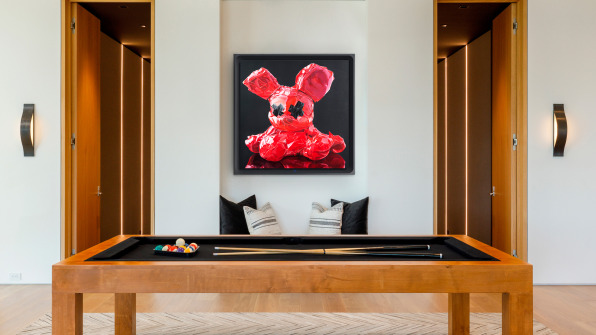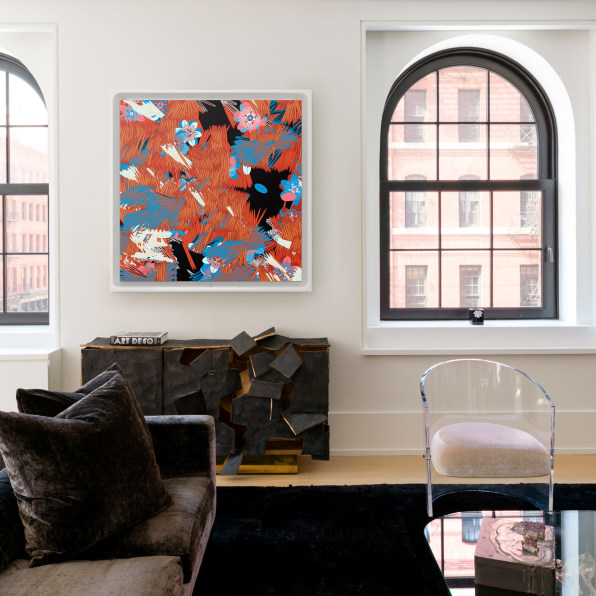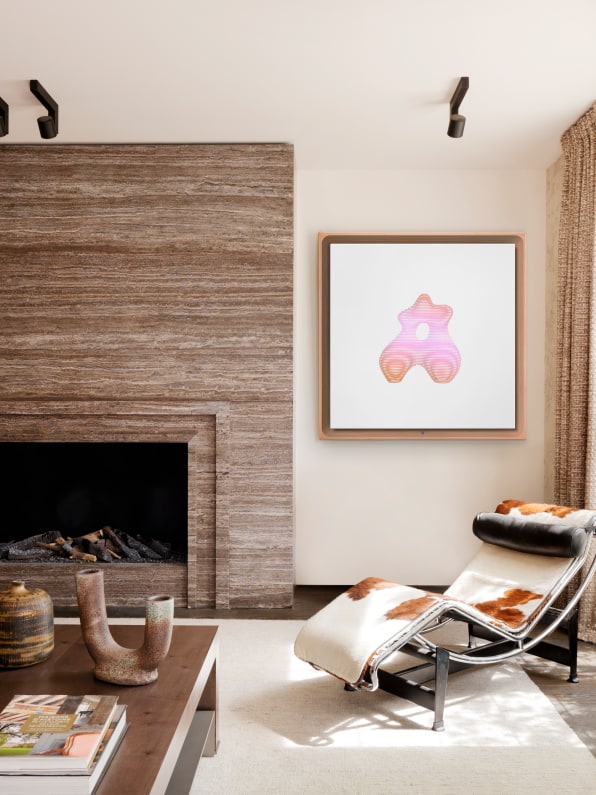
At this year’s edition of The Armory Show, a major annual international art fair opening in New York on September 9, the big ticket paintings of contemporary artists and the collections of top-tier art galleries will be joined by a slightly odd debut exhibitor called Danvas. It’s not an art maker nor an art dealer: It’s an art display. Measuring four feet by four feet and selling for $34,500, Danvas’s display is a high-end screen for showing a type of art that seems to suddenly be everywhere.
 Designed to display digital art, and heavily influenced by the advent of art being produced and sold as NFTs, Danvas is trying to set a new standard for the ways digital art is exhibited, sold, and appreciated.
Designed to display digital art, and heavily influenced by the advent of art being produced and sold as NFTs, Danvas is trying to set a new standard for the ways digital art is exhibited, sold, and appreciated.
“We think [digital art] is just as beautiful and just as worthy as anything else hanging at the Armory and we want the traditional art world to see it that way,” says Jeanne Anderson, cofounder of Danvas. “We also want digital artists to be celebrated that way.”
 Anderson formerly worked for the large art gallerist Saatchi Art, and experienced firsthand how hard it was for digital art to be displayed. “Digital artists really were misunderstood. The artwork that they created was remarkable, but it couldn’t sell very easily,” she says. “Often it would be like, ‘Okay, I’m going to pay you and you’re going to send me a file, but then what do I do?'”
Anderson formerly worked for the large art gallerist Saatchi Art, and experienced firsthand how hard it was for digital art to be displayed. “Digital artists really were misunderstood. The artwork that they created was remarkable, but it couldn’t sell very easily,” she says. “Often it would be like, ‘Okay, I’m going to pay you and you’re going to send me a file, but then what do I do?'”
If the works did get sold, they’d typically be displayed on a repurposed television, tablet, or computer, or, more commonly, on the tiny screen of a phone, “which is just not how the world should be seeing beautiful digital art,” Anderson says.
 About a year ago, Anderson and her cofounder Hernan Lopez, started dreaming up a better way, focusing on rethinking how both gallerists and art collectors could put digital art up on walls. The recent explosion of NFT art–more than $8 billion worth of NFT artworks and digital collectibles were sold in 2021, according to the Art Market 2022 Report–was also a factor.
About a year ago, Anderson and her cofounder Hernan Lopez, started dreaming up a better way, focusing on rethinking how both gallerists and art collectors could put digital art up on walls. The recent explosion of NFT art–more than $8 billion worth of NFT artworks and digital collectibles were sold in 2021, according to the Art Market 2022 Report–was also a factor.
The Danvas Series G, the company’s first retail product, is making its launch at the Armory Show with an exhibition of works by seven digital artists. Designed by industrial design studio Ammunition, known for its work on the Beats by Dre headphones (and the trophy for Fast Company‘s Innovation by Design awards), the display uses Micro LED technology for a glare-free presentation. “You can appreciate it in any light,” Anderson says. The screen is surrounded by a wooden frame that also doubles as an acoustic channel for digital art that has audio elements.
Displaying digital art at this size and clarity is not cheap. The Danvas Series G’s $34,500 price tag, Anderson says, is a reflection of the quality of the technology and the elegance of the design, but also an argument for the legitimacy of digital art. “We intentionally decided that our first product would be a large-scale, really stunning Micro LED display, because we think this artwork is worthy of being hung that way,” Anderson says. “At the premium art level, when you’re talking about other artwork that’s selling at the Armory, the frames that those artworks are hung in are also in that price range.”
 “If you’re buying a Basquiat, of course it would be in an expensive frame,” Anderson adds.
“If you’re buying a Basquiat, of course it would be in an expensive frame,” Anderson adds.
Indeed, some digital art is now valued similarly to the works of well-known non-digital artists. In a recent video call, Anderson points to one of the Danvas displays on her office wall showing a work by the digital artist Pak, who recently sold nearly $17 million worth of NFTs at a Sotheby’s auction. “I wouldn’t put that into a TV turned on its side,” Anderson says.
 But some of the so-called art being sold as NFTs may not even deserve that. Speculation in NFTs has led to a flood of digital images being created as transparent cash grabs. Anderson acknowledges that some creators and many collectors in the NFT art space are more interested in profit than artistic expression, but the resulting artworks may still be worth putting up on a living room wall. “NFT crypto-native guys that are collecting for trading value, I think they also have a right to put their work into something beautiful,” Anderson says. “If you’re collecting because you want to participate in a value structure and you want to benefit from that, it doesn’t mean you don’t want to display it.”
But some of the so-called art being sold as NFTs may not even deserve that. Speculation in NFTs has led to a flood of digital images being created as transparent cash grabs. Anderson acknowledges that some creators and many collectors in the NFT art space are more interested in profit than artistic expression, but the resulting artworks may still be worth putting up on a living room wall. “NFT crypto-native guys that are collecting for trading value, I think they also have a right to put their work into something beautiful,” Anderson says. “If you’re collecting because you want to participate in a value structure and you want to benefit from that, it doesn’t mean you don’t want to display it.”
For all the forgettable NFTs available on crypto markets, there is still a growing cadre of serious digital artists pushing the boundaries of contemporary art, Anderson says. Danvas is in conversations with many of these artists about partnerships and ways to improve the Danvas display for emerging forms, such as generative art.
Though Anderson says the company wants its displays to help push digital art forward, at their core the displays are meant to give this art a place to be shown and appreciated. “Collectors who really care about their artwork and want to make sure it’s seen in a beautiful display are people that are at the heart of what we think about on a daily basis,” she says.





